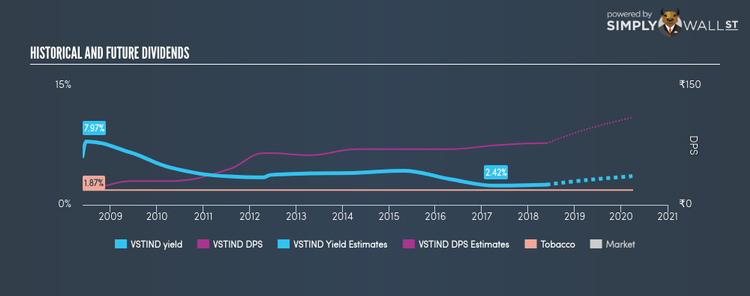Why Dividend Hunters Love VST Industries Limited (NSE:VSTIND)

VST Industries Limited (NSEI:VSTIND) has pleased shareholders over the past 10 years, paying out an average dividend of 4.00% annually. The company currently pays out a dividend yield of 2.55% to shareholders, making it a relatively attractive dividend stock. Does VST Industries tick all the boxes of a great dividend stock? Below, I’ll take you through my analysis. View our latest analysis for VST Industries
How I analyze a dividend stock
If you are a dividend investor, you should always assess these five key metrics:
Is its annual yield among the top 25% of dividend payers?
Has its dividend been stable over the past (i.e. no missed payments or significant payout cuts)?
Has dividend per share amount increased over the past?
Does earnings amply cover its dividend payments?
Will it be able to continue to payout at the current rate in the future?
How does VST Industries fare?
The company currently pays out 65.80% of its earnings as a dividend, according to its trailing twelve-month data, meaning the dividend is sufficiently covered by earnings. In the near future, analysts are predicting a payout ratio of 68.54%, leading to a dividend yield of around 3.28%. In addition to this, EPS should increase to ₹137.3. If there’s one type of stock you want to be reliable, it’s dividend stocks and their stable income-generating ability. VSTIND has increased its DPS from ₹20 to ₹77.5 in the past 10 years. It has also been paying out dividend consistently during this time, as you’d expect for a company increasing its dividend levels. These are all positive signs of a great, reliable dividend stock. In terms of its peers, VST Industries has a yield of 2.55%, which is high for Tobacco stocks.
Next Steps:
With this in mind, I definitely rank VST Industries as a strong dividend stock, and makes it worth further research for anyone who likes steady income generation from their portfolio. Given that this is purely a dividend analysis, I urge potential investors to try and get a good understanding of the underlying business and its fundamentals before deciding on an investment. Below, I’ve compiled three essential aspects you should look at:
Future Outlook: What are well-informed industry analysts predicting for VSTIND’s future growth? Take a look at our free research report of analyst consensus for VSTIND’s outlook.
Valuation: What is VSTIND worth today? Even if the stock is a cash cow, it’s not worth an infinite price. The intrinsic value infographic in our free research report helps visualize whether VSTIND is currently mispriced by the market.
Other Dividend Rockstars: Are there better dividend payers with stronger fundamentals out there? Check out our free list of these great stocks here.
To help readers see pass the short term volatility of the financial market, we aim to bring you a long-term focused research analysis purely driven by fundamental data. Note that our analysis does not factor in the latest price sensitive company announcements.
The author is an independent contributor and at the time of publication had no position in the stocks mentioned.

 Yahoo Finance
Yahoo Finance 
